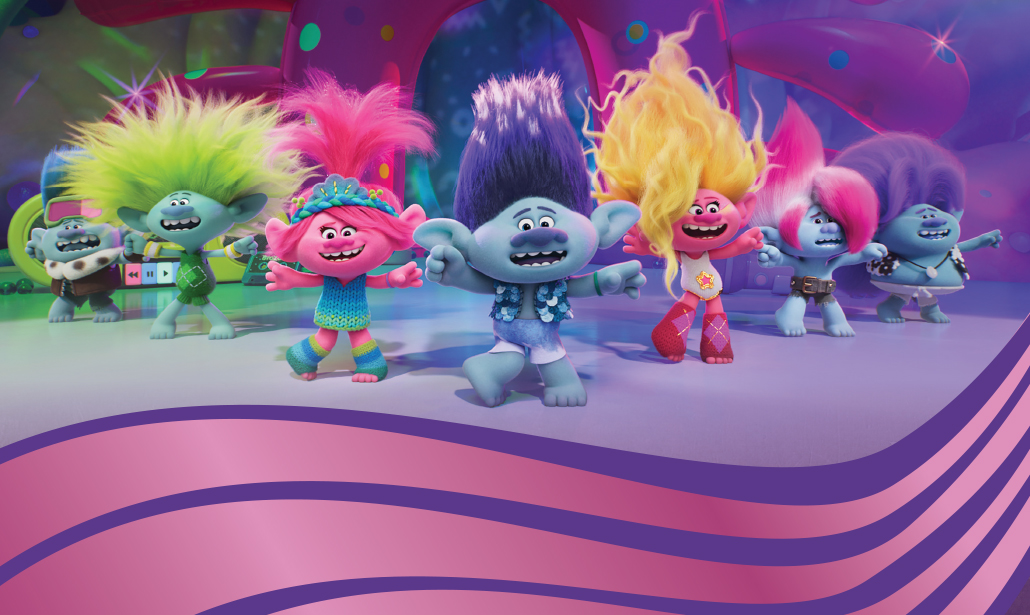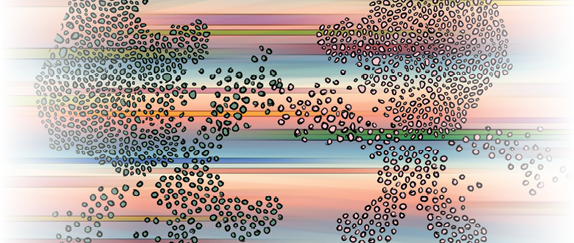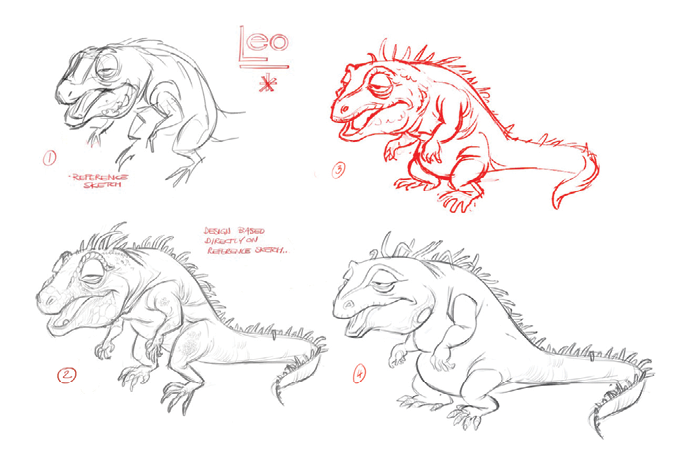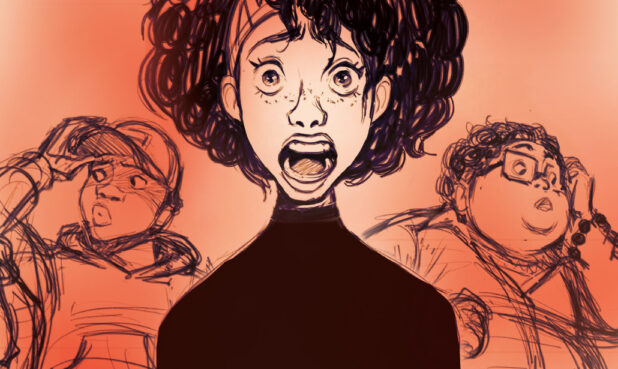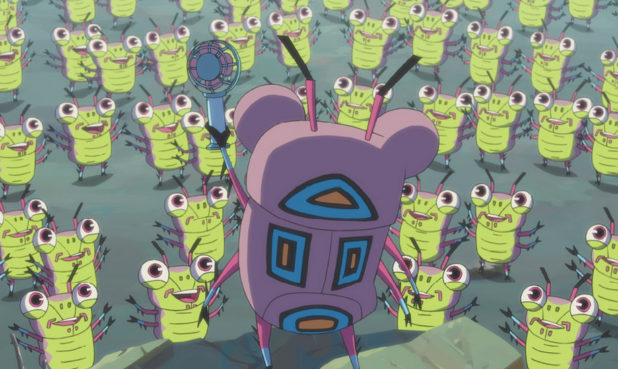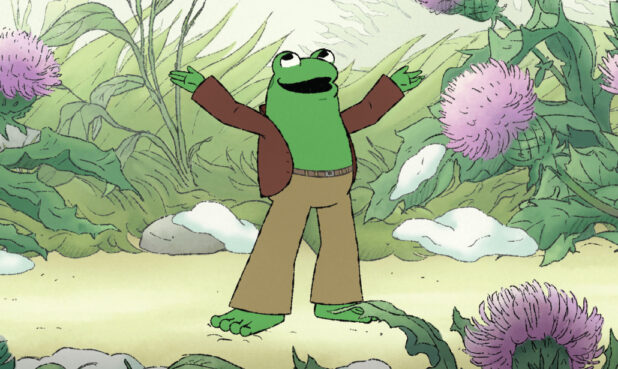Bust A Move
Getting the band back together takes on new meaning in DreamWorks Animation’s latest Trolls movie, Trolls Band Together. Branch, protagonist of the previous films, must reunite with his family band, BroZone, in order to rescue their brother Floyd from an evil popstar duo. Only the perfect harmony sung by the brothers can shatter the diamond prison and set Floyd free. What follows is a musical road-trip adventure.
With the film’s focus on boy bands, Head of Character Animation Ben Willis says he realized that the animation team needed to do a deep dive into dance, with dance moves that should be a true homage to the genre. He didn’t want to do just big poses, but rather wanted the poses to feel authentic to the style of dance they were trying to recreate.
The film’s animators participated in “Road Trip Week,” an intensive learning experience for which Animation Supervisor Brooke Shay Bradford introduced music theory and dance, while another supervisor created lessons on singing. Bradford had studied dance and choreography back before animation was even on her radar, and she now realizes how much her background and passions have influenced her animation work. “When I started on Trolls, it was like, ‘Oh, this is what it was all for. This is why I got into this,’” she says. She advises colleagues to pursue their passions “because it really feeds the work that we do as animators.”
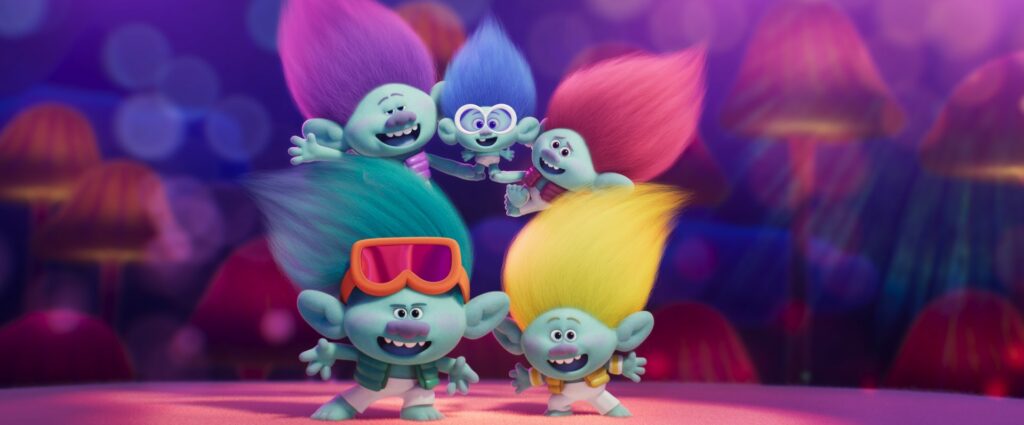
For the music theory lessons, Bradford included song structure, rhythm, and syncopation, and how to count beats and find the pulse of the music. She showed animators how to break that down and translate it into frames per second on a timeline. She wanted to provide the animators with a blueprint to work with, so if they didn’t have the choreography for a particular moment, they would be able to use their new understanding about the music and experiment to come up with their own moves.
Bradford’s own method is to first get familiar with the music and count out the beats. Then she’ll figure out the overall song structure, taking note of chorus, verse, and changes in dynamics or volume. All this, she says, plays into what you do with the dance. She’ll spend time visualizing before studying the choreography created by Justin Timberlake’s choreographers, Marty Kudelka and AJ Harpold, who mapped out the film’s dance sequences.
Using the choreography reference, Bradford introduced the principles of dance to the animators, such as the direction dancers are moving, their location, and how high and low they are in relation to each other. Other considerations included identifying where the center of gravity is, which part of the body is leading, and the different pathways dancers are taking to move a certain part of the body or to get from one location to another. All of these elements are important to create dance sequences that feel realistic despite the cartoonish shape of the characters.
For example, Bradford looked at the posing of hands and feet and how they impact the overall silhouette. Clear silhouettes are especially important for the style in a Trolls film. What can be challenging, she says, is that the proportions of the troll characters don’t allow a lot of room for big movement; they have stubby limbs and fingers, and giant heads. “So what you can take from the choreography and translate onto a troll’s body is very limited,” she explains.
In addition to the principles, Bradford reviewed the dynamic qualities of movement—suspended, sustained, percussive, etc.—and how they can be exaggerated by the animator to add texture and clarify the performance, which can be pushed in the Trolls animation style. “There’s a lot of … hidden scaling of limbs … just to try to get the poses to read clearly for the audience,” Bradford says. If the choreography requires a low knee-bend pose, for example, the animators exaggerated and lengthened the legs so that viewers can read that knee bend and silhouette. Having previously worked on Trolls World Tour, the choreographers knew that the trolls can’t put their arms overhead, and they would try to avoid that. There was a lot of taking the essence of a pose and reconfiguring it to work with the trolls’ proportions.
Willis points out that animating dance can be intimidating, which is why he wanted to get into the specifics of speaking the language of dance to prepare the animators. As part of this learning process, he tasked animators with coming up with components that would only be possible in the Trolls’ universe. “So it wasn’t just taking the dance reference and interpreting it,” he says. “It was also like, can you ‘troll-ify’ it? Or can you do something where the Troll defies gravity, or uses their hair some way, to dance.”
Willis says that while they had the freedom to interpret, overall they stayed true to what the choreographers came up with, and that, along with the deep dive into music and dance, paid off, resulting in sequences that feel genuine as well as entertaining and fun.

Grumpy Old Man
How do you create a relatable reptile who’s grumpy but likeable and has emotional depth? This was the challenge for Animation Director Jason Figliozzi and the creative team on Netflix’s Leo, a movie that revolves around an eponymous classroom pet, a lizard who learns that at 74 he has only one year left to live. With time running out, Leo plans to escape the terrarium he shares with Squirtle, a cranky turtle, but those plans fall apart when a mean substitute teacher arrives and Leo ends up serving as the class therapist.
The story unfolds across multiple settings, from a classroom terrarium to the Everglades, but the heart of the film is about kids who are leaving fifth grade and going into middle school, and their emotional journeys during this transition. To authentically capture that, says Figliozzi, “We really just tried to dive into us at that age.” They also spoke to fifth graders to find out what drives and worries them on a daily basis.

As for Leo, the starting point was a species of reptile called a tuatara. Figliozzi says there were many versions of this lizard-like creature before it finally evolved into the Leo found onscreen. Trying to figure out what an old lizard would look like factored into that evolution. For references, they studied quadrupeds and reptiles and watched how they move. Then they pushed it from there to make a character that was uniquely their own.
Figliozzi and his animation team created rules for keeping Leo in character. “Leo is a 74-year-old lizard, so we wanted him to feel that age,” he says. This meant that his movements had to be slow, deliberate, and methodical, with small gestures to show that he’s conserving energy. They paid close attention to his elbows. “If you brought his elbows out and revealed that negative space under his arms, he automatically felt younger,” says Figliozzi, adding that if they moved him too fast, this also made him feel more youthful and useful, so they minimized his movement. They also took care to ensure that his tail did not feel snaky or serpent-like, keeping it mostly behind him, except for scenes where he uses it like an appendage.
Figliozzi describes a moment when fifth-grader Mia tells Leo, “You remind me of my grandpa.” He says they brought that warmth of a favorite relative to the character to help with the emotional connection. They achieved this with the shaping of Leo’s eyebrows and by being careful not to make Leo look mad, particularly when he’s speaking to the children. “He could skew angry pretty quickly,” says Figliozzi. “If we just brought … his inner brows down a little bit, he would turn into a different character, and we really didn’t want him to feel off-putting or irritated in any way.” They kept his brows up higher and made his eyes look kind by pushing his lower lids up a little bit.
“Hopefully you feel the warmth and the contrast between when he’s hanging out with the kids … compared to where he was in the beginning of the film.” —Jason Figliozzi, Animation Director, Leo
When Leo and Squirtle are alone in their terrarium, they are curmudgeons, and Figliozzi says that there’s a nice contrast between Leo as a scowling grump and the arc of his personality getting warmer as he starts to enjoy helping the kids. “There’s a sweetness to him,” says Figliozzi, that’s conveyed by subtle smiles and happy eyes. “Hopefully you feel the warmth and the contrast between when he’s hanging out with the kids … compared to where he was in the beginning of the film.”
One of Figliozzi’s favorite sequences is where Leo is singing Mia to sleep and put her at ease. Even though Leo genuinely thinks the words of the song are helpful, in fact they aren’t very nice, and he’s unintentionally giving bad advice. “I think that’s one of the funniest, but also warmest scenes, of the movie. It’s just a really funny mash-up of sincerity with harshness,” Figliozzi says, noting how tricky it was to find that balance.

Instead of having Mia respond in a big way to the song, she listens quietly and conveys her emotion in her eyes. “There’s a moment of her looking taken aback and a really subtle eyebrow raise and an eye flare right when Leo starts singing, which I think hits really well,” says Figliozzi. This is in contrast with Leo, who’s very performative and who’s smiling, not realizing the lyrics are actually dismissive of Mia’s emotions.
Layering all these nuances was challenging, and they worried that it could come across as mean. But at a screening, when the audience laughed at the first line of the song, it hit home that people connected with it. Figliozzi also gives much credit to Adam Sandler’s performance which he says combined with the filmmakers’ artistry to make Leo “animation gold.”
